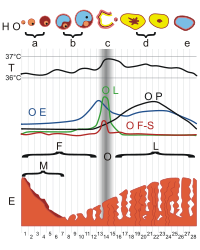
Photo from wikipedia
BACKGROUND The recurrence of menstrual symptoms markedly interferes with the daily life, social functioning, work disability and quality of life of women. Patient perception of healthcare services is underexplored but… Click to show full abstract
BACKGROUND The recurrence of menstrual symptoms markedly interferes with the daily life, social functioning, work disability and quality of life of women. Patient perception of healthcare services is underexplored but crucial for understanding how to efficiently develop healthcare practices. AIMS To identify and describe the different patterns of treatment expectation and physician-patient relationships perceived by women receiving traditional Chinese medicine treatment for menstrual symptoms. METHODS A two-stage data collection design was used. In the first stage, in-depth interviews with 40 participants were conducted; the interview data were used for content analysis. Q statements were developed on the basis of the content analysis results. In the second stage, a series of Q sorts was performed by 60 other participants to subjectively rank the Q statements. RESULTS The results of factor analysis revealed that four factors retained in the final model accounted for 56% of total variance. Women associated with Factor 1 had experienced few negative physician-patient interactions; these women were relatively young (31.6 years) and had mild perimenstrual mood discomfort (6.4). Women who loaded on Factor 2 preferred physician guidance and encountered few barriers to adherence; these participants were older (38.6 years) and had the most severe perimenstrual mood discomfort (9.5) among the four groups. The women in agreement with Factor 3 tended to patiently wait for treatment effects; these participants had the highest scores for both cyclic pelvic pain (4.9) and perimenstrual physical discomfort (8.8). The women associated with Factor 4 demanded effective treatment and had the lowest scores for both cyclic pelvic pain (3.8) and perimenstrual physical discomfort (6.8). CONCLUSIONS The exploration of clustering patients according to their perspectives could influence healthcare providers to acknowledge patient expectations and enable effective communication between physicians and patients.
Journal Title: Scandinavian Journal of Caring Sciences
Year Published: 2017
Link to full text (if available)
Share on Social Media: Sign Up to like & get
recommendations!